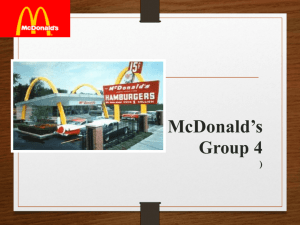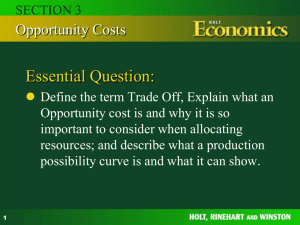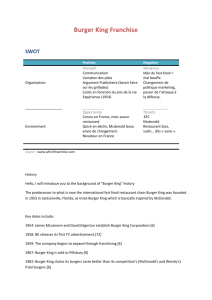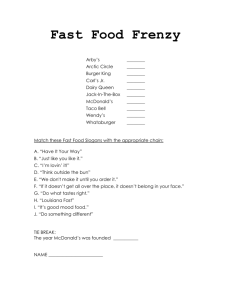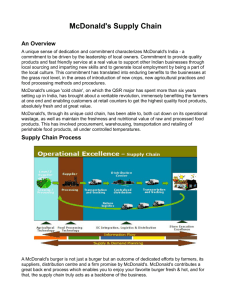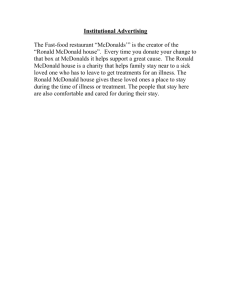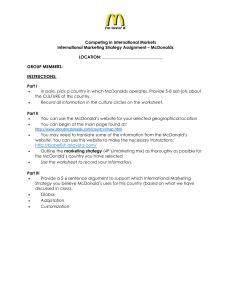File
advertisement
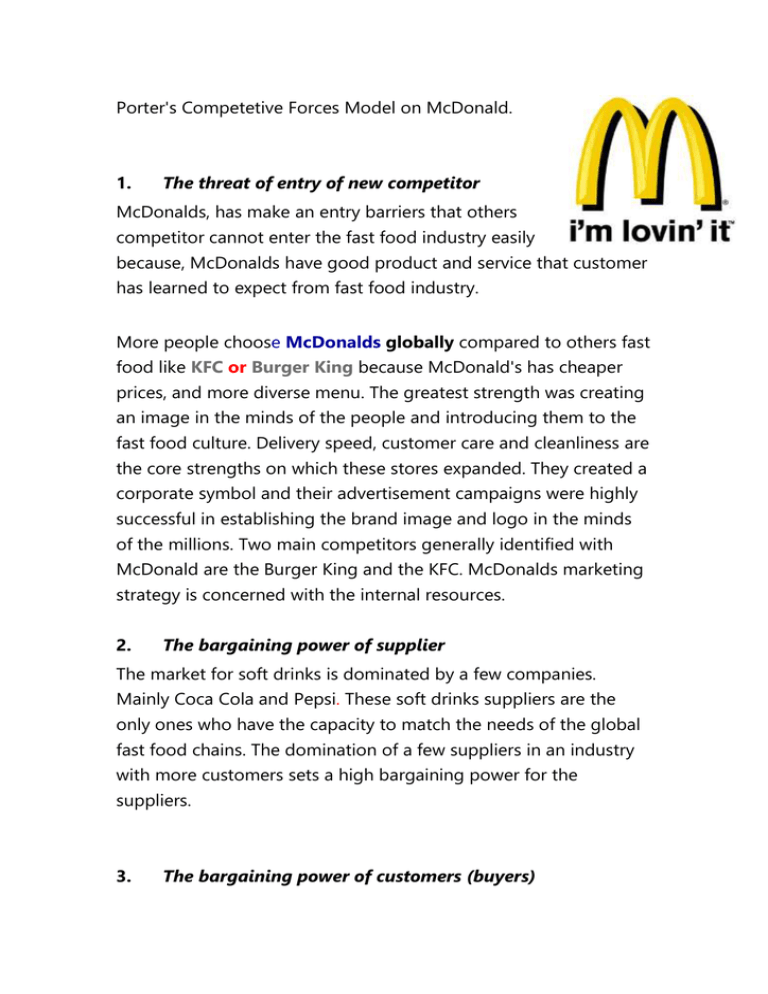
Porter's Competetive Forces Model on McDonald. 1. The threat of entry of new competitor McDonalds, has make an entry barriers that others competitor cannot enter the fast food industry easily because, McDonalds have good product and service that customer has learned to expect from fast food industry. More people choose McDonalds globally compared to others fast food like KFC or Burger King because McDonald's has cheaper prices, and more diverse menu. The greatest strength was creating an image in the minds of the people and introducing them to the fast food culture. Delivery speed, customer care and cleanliness are the core strengths on which these stores expanded. They created a corporate symbol and their advertisement campaigns were highly successful in establishing the brand image and logo in the minds of the millions. Two main competitors generally identified with McDonald are the Burger King and the KFC. McDonalds marketing strategy is concerned with the internal resources. 2. The bargaining power of supplier The market for soft drinks is dominated by a few companies. Mainly Coca Cola and Pepsi. These soft drinks suppliers are the only ones who have the capacity to match the needs of the global fast food chains. The domination of a few suppliers in an industry with more customers sets a high bargaining power for the suppliers. 3. The bargaining power of customers (buyers) Since the industry is flooded with many different kinds of fast food and many different suppliers of fast food, then the buyer are in a situation where many suppliers are offering products that have a certain similarity. Since the global fast food chains have been trying to match each others successful products and product packages, then the buyers can actually buy similar products from multiple suppliers, and that is a situation the empowers the buyer. Furthermore, if the fast food industry does not match the demands of the buyers and the general consumer trends, then the buyers can choose not to buy their product and convince others to do the same. 4. The threat of substitute products or services The generic products of fast food are mainly considered as convenience. Convenience and availability are the main drivers for choosing fast food. However, this is backed up by focus on value. Since the market as a whole consists of many differentiated fast food companies, then the customers are used to having the option of choosing the best value products. The value of the substitute products in general matches the fast food products and the consumer preferences of the consumers. The substitute product offers both cheap value meals and quality products for both ends of the quality scale that the fast food industry normally targets. Furthermore, it offers healthy alternatives to match the consumer needs and wishes. 5. The rivalry among existing firms in the industry · McDonald however is far larger than most in the industry with 31,000 outlets compared to its nearest hamburger competitor Burger King, with 11,500 (Reuters, 2008). KFC (owned by 2nd largest competitor Yum! Brands (Yahoo7finance, 2008), Burger King and countless others sell similar product to McDonald. · McDonald traditional competitors include many of the other fast food outlets across the country has been shown that the presence of a Burger King, for example, will increase the likelihood that McDonald will open near by. Thus, it can be seen that the threat of competition from traditional rivals is intense and should never be over looked. · In general, McDonald and its main competitors (Burger King Corporation, Wendy's International, Inc., Hardee's, and Jack in the Box) are active in making fresh moves to improve their market standing and business performance by introducing their product innovation and launching many outlets franchise. · A good example of this would be the price competition between multiple fast food chains’ value meals. · Price dumping is normally a good way to attract new customers, or stealing customers from competing companies, and since it have been a growing consumer trend to go after these value meals, then it is a product category that have been adapted from most of the global fast food companies. · The high level of competition forces the individual competitors to copy of each others are products and ideas quickly since the competitors are always keeping an eye out for new ideas for themselves, and so far there have been no way of protecting a burger or sandwich recipe. In Malaysia, every Chinese New Year, there will be a prosperity burger. Thereby they have found a way to differentiate, which gives them a bit more space to move in, and thereby a little less fierce competition. · The main competition goes through the branding. In addition, the competition to create the strongest brand is fierce. Firstly, normal advertising through TV, posters radiocommercials are regular. However, the biggest brands like McDonald’s and Burger King have been branding their own brand through piggy backing on other brands power.
